Wildlife Safety Tips For Hiking: The Ultimate Guide (With Statistics)

When it comes to hiking injuries and risks, attacks or danger from wildlife are quite low on the totem pole. In fact, you’re more likely to be struck by lightning than attacked by a bear while hiking. Nevertheless, it’s always good to be prepared and know what to do if you should encounter a dangerous animal while out on the trail. This article will cover some important trends and stats about the wildlife you’ll encounter, general safety precautions, and a breakdown of the most common wildlife you’ll see on the trails.
Quick Links
8 General Safety Tips For Wildlife
No matter where you hike, always take some basic safety precautions to protect yourself from wildlife:
Be Aware of Your Surroundings
and make noise. This will help you avoid surprises and also let animals know you’re coming so they can avoid you.
Don’t Hike Alone
There’s safety in numbers, and if something does happen, someone will be there to help. In addition, most wildlife will be cautious of approaching a larger group of people vs. a single individual.
Carry Bear Spray
Bear spray is a non-lethal way to deter a bear attack and can also be used on other animals like cougars. Just because it’s named “bear spray,” don’t think you don’t need it if you’re not hiking in bear country. In fact, bear spray is effective against all kinds of animals, including coyotes, dogs, and even snakes. Essentially, bear spray is pepper spray on steroids and can be a hiker’s best friend against wild, aggressive animals.
Stay on The Trail
This will help you avoid getting lost, but it also helps reduce your impact on the environment and keep you away from areas where animals might be hiding or feeding.
Don’t Approach or Feed Wildlife
This may seem like common sense, but it’s become a major problem over the years. When animals are fed by humans, they become accustomed to people and lose their natural fear of us. This can lead to aggressive behavior and even attacks.
Keep Your Campsite Clean and Free of Food
Store all food, garbage, and anything with a scent in a bear-proof container or hung from a tree out of reach of animals.
Be Extra Careful During Mating Season
Many animals become more aggressive during mating season, so it’s best to give them a wide berth during these times. How do you know if it’s their mating season? Well, the first step is to know what type of wildlife you’ll encounter on your trail. Then, research their mating habits and plan your hike accordingly.
Be Cautious when Hiking at Dawn or Dusk
Believe it or not, this is when many animals are most active, so it makes sense to take a few extra precautions during these times. If you plan on doing any night hiking or stargazing, you need to be extra careful and always hike with a partner.
The Most Common Wildlife You’ll Encounter While Hiking
Different animals require different responses, so familiarize yourself with what to do before you go. Here are some of the most common animals you’ll encounter and what to do if you should see them while hiking:
Alligator

Alligators are native to the southeastern United States and can be found in swamps, rivers, lakes, and bayous. If you encounter an alligator on the trail, the best thing to do is to slowly back away and give it a wide berth. Remember, alligators are stealthy predators and can strike quickly, so don’t take any chances. The last thing you want to do is make the alligator feel threatened because that’s when they’ll attack. A female alligator, in particular, may turn hostile if her nest is endangered.
Facts About Alligators
- How it attacks: BIG bites
- Bite Force: 3000 PSI
- Top Speed: 20 MPH
- Length: Up to 20 Feet
- Diet: Fish, Small mammals, birds, reptiles, and carrion
- Learn more about what to do if you encounter an alligator while hiking
Black Bear
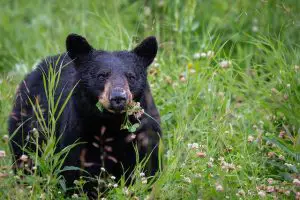
Black bears are found in forested areas across the continent and are generally shy and unaggressive animals. In general, black bears are wary creatures who will seek to avoid interaction with people. However, a few factors may set them off, such as being startled or feeling threatened. In addition, if the black bear has gotten used to people feeding it, it may become aggressive in search of food. If you see a black bear on the trail, make yourself as big and loud as possible to scare it off, and never approach or feed the animal.
Facts About Black Bears
- How it attacks: Claws, swipes and bites
- Bite Force: 800 PSI
- Weight: Males 200-600 lbs, Females 150-400 lbs
- Length: Males 5-6 feet, Females 4-5 feet
- Diet: Omnivorous, but 70% of their diet is plants
- Learn more about what to do if you encounter a black bear while hiking
Brown Bear (Grizzly Bear)
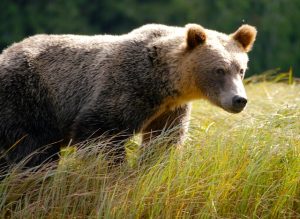
Brown bears, also known as grizzly bears, are found in forested areas of North America, Europe, and Asia. They are much larger and more aggressive than black bears and should be treated with extreme caution if you encounter one on the trail. Brown bears are not usually hostile toward people, but they may be dangerous if they feel threatened. Additionally, a brown bear will attack if it believes its cubs are in danger. But the truly terrifying thing about brown bears is that they are completely unpredictable. Even if a brown bear has never demonstrated aggression toward humans previously, it is always probable that it may do so in the future.
Facts About Brown Bears
- How it attacks: Claws, swipes and bites
- Bite Force: 1200 PSI
- Weight: Males 600-1200 lbs, Females 400-800 lbs
- Length: Males 7-8 feet, Females 6-7 feet
- Diet: Omnivorous, but 90% of their diet is plants
- Learn more about what to do if you encounter a brown bear while hiking
Bobcat

Bobcats are found in wooded areas throughout North America and are generally shy animals that will avoid contact with humans. If the bobcat does not back away or approach you in a threatening manner, you may need to protect yourself. If you have pepper spray or bear spray, this is the easiest method to follow. If this is not possible, look for a big stick or rock to hurl at the bobcat.
Facts About Bobcats
- How it attacks: Uses its claws
- Weight: 10-30 lbs
- Length: 2-3 feet
- Diet: Small mammals, birds, reptiles, and amphibians
- Learn more about what to do if you encounter a bobcat while hiking
Coyote
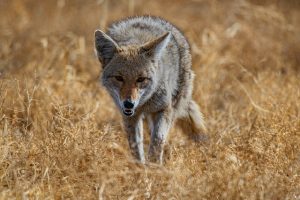
Coyotes are found throughout North and South America and are relatively small compared to other canids. Coyotes are clever creatures who have adapted effectively to live around people, which is clearly a huge reason for worry. If you come across a coyote while hiking, make yourself as large as possible and make a lot of noise. Coyotes, unlike larger creatures such as brown bears, are usually frightened off by loud sounds and larger individuals (which is why they target smaller prey.)
Facts About Coyotes
- How it attacks: Bites
- Bite Force: 88 PSI
- Weight: 15-30 lbs
- Length: 2-3 feet
- Diet: Small mammals, birds, reptiles, and amphibians
- Learn more about what to do if you encounter a coyote while hiking
Deer

Deer are found in wooded areas across the globe and are generally shy animals that will avoid contact with humans. Deer are often relatively gentle creatures that may play among themselves or in groups. Even if a deer spots you from a distance, odds are they won’t want to approach you or even get near to you. Only if you startle a deer or approach too near to their young should you be worried about them trying to protect themselves and their family. Aside from that, they’re more likely to flee from you than anything else.
Facts About Deer
- How it attacks: Charges with antlers
- Weight: Males 150-250 lbs, Females 100-200 lbs
- Length: Males 4-5 feet, Females 3-4 feet
- Diet: Omnivorous, but 70% of their diet is plants
- Learn more about what to do if you encounter a deer while hiking
Moose
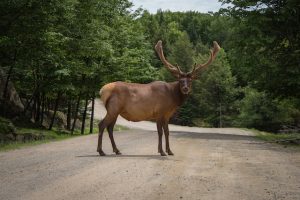
Moose are found in wooded areas of North America, Europe, and Asia. They are the largest member of the deer family and can be very dangerous if they feel threatened. Moose are generally calm creatures, but they may be aggressive if confronted. A moose may rush at you and attack if you startle it. Moose are also more prone to strike during the fall mating season (September-October), so keep that in mind if you’re trekking then.
Facts About Moose
- How it attacks: Charges with antlers
- Weight: Males 1500-2000 lbs, Females 1000-1500 lbs
- Length: Males 6-8 feet, Females 5-7 feet
- Diet: Omnivorous, but 80% of their diet is plants
- Learn more about what to do if you encounter a moose while hiking
Mountain Goat

Mountain goats are found in mountainous regions of North America, Europe, and Asia. When a mountain goat feels threatened, they are known to butt people with their horns. This may not seem to be very frightening, but considering that mountain goats may weigh up to 350 pounds, it can clearly cause significant damage. If you spot a mountain goat, allow it lots of room to roam. If one approaches you, make yourself as large as possible and make loud sounds to frighten it away.
Facts About Mountain Goats
- How it attacks: Charges with horns
- Weight: Males 150-250 lbs, Females 100-200 lbs
- Length: Males 4-5 feet, Females 3-4 feet
- Diet: Omnivorous, but 70% of their diet is plants
- Learn more about what to do if you encounter a mountain goat while hiking
Mountain Lion (Cougar)

Mountain lions, also known as cougars, are found in forested areas of North and South America. They are much larger than coyotes and bobcats, and can be very dangerous if they feel threatened. If you come across a mountain lion while hiking and the mountain lion starts to approach you – the best thing to do is become as as large as possible. Raise your arms and wave them around. Playing dead is the absolute worst approach for dealing with a mountain lion. Mountain lions, unlike other wild creatures, will simply see you as “weak” and easy prey if you choose to play dead.
Facts About Mountain Lions
- How it attacks: Charge and ambush prey from behind
- Bite Force: 400 PSI
- Weight: Males 150-250 lbs, Females 100-200 lbs
- Length: Males 4-5 feet, Females 3-4 feet
- Diet: Omnivorous, but 70% of their diet is plants
- Learn more about what to do if you encounter a mountain lion while hiking
Wild Boar
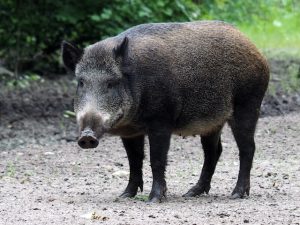
Wild boars, also known as feral pigs, are found in wooded areas of Europe, Asia, and Africa. If a wild boar starts to get closer to you or appears agitated, back away carefully. Whatever you do, don’t run away or turn your back on the animal. Second, do not run. I understand that this is intuitive, but it will just exacerbate the problem. Boars are quick on their feet, and if you attempt to outrun them, they will catch up to you. When you start running, their hunting and chasing instinct kicks in, as it does with many other animals.
Facts About Wild Boars
- How it attacks: Charge right at their prey
- Bite Force: 250 PSI
- Weight: Males 150-250 lbs, Females 100-200 lbs
- Length: Males 4-5 feet, Females 3-4 feet
- Diet: Omnivorous, but 70% of their diet is plants
- Learn more about what to do if you encounter a wild boar while hiking
Wolves

Wolves are found in wooded areas of North America, Europe, and Asia. They are much larger than coyotes and bobcats, and can be very dangerous if they feel threatened. Although wolves are typically fearful of people, they will attack if they feel threatened or trapped. Wolves usually strike from behind, aiming for the back of the neck or the head. If you come across a wolf while hiking, the best thing you can do is remain calm and become as large as possible. Raise your arms over your head and make loud sounds to make yourself seem as unappealing as possible.
Facts About Wolves
- How they attack: Pack hunting, will go for the throat
- Bite Force: 400 PSI
- Weight: Males 150-250 lbs, Females 100-200 lbs
- Length: Males 4-5 feet, Females 3-4 feet
- Diet: Omnivorous, but 70% of their diet is plants
- Learn more about what to do if you encounter a wolf while hiking
11 Fascinating Wildlife Attack Statistics
Now that we’ve gone over some general safety tips and some brief information on some of the wildlife you’ll encounter, let’s take a look at some statistics (my favorite part!). These will help you understand just how rare it is to encounter a dangerous animal while hiking:
1#. According to the International Hunter Education Association, the chance of being attacked by a bear is about 1 in 2.1 million. The odds of being struck by lightning are about 1 in 700,000.
2#. In the United States, there are roughly 40 brown bear attacks per year.
3#. There are an estimated 1-2 million coyotes in North America, and yet there have only been two documented fatalities from coyote attacks in the last 100 years.
4#. According to the Humane Society, coyote attacks on people are very rare. More people are killed by errant golf balls and flying champagne corks each year than are bitten by coyotes.
5#. There is an estimated 5,000,000 alligators aross the United States, and only 15 fatalities reported from alligator attacks between 1948 to 2004.
6#. There hasn’t been a single record of a fatal bobcat attack in human history.
7#. In the United States, there have been 27 fatal mountain lion attacks in the last 100 years. That’s an average of about 1 per every 4 years.
8#. There have only been two documented fatalities from wolves in the past 100 years.
9#. In North America, moose attacks happen roughly 5-10 times per year. Which is actually more than brown bear and black bear attacks combined.
10#. In the United States, there has been only four reported fatalities from feral hogs throughout history.
11#. Compared to the deadliest animal (not on this list) is the mosquito. Mosquitos kill between 750,000 to 1,000,000 people worldwide, per year. Sometimes it’s not the animals you can see that pose the greatest threat.
Conclusion
As you can see, the chances of being attacked and killed by a wild animal are actually quite slim. However, that doesn’t mean that you should let your guard down entirely. There are still some very real dangers out there, and it’s important to be prepared. Make sure you know what to do if you encounter any of the animals on this list (check our detailed guides to learn more), and always hike with a partner if possible.
Do you have any stories about encounters with wildlife while hiking? I would love to hear them in the comments!






